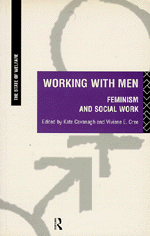

![]()
![]()

A major strength of the book is its optimistic tone in arguing that it is possible to work with men in a way that does not deny feminist principles. And, it gives practical examples of where this has been done, for example, the CHANGE Project in Scotland, which has a chapter in its own right. Some of the chapters undertake research aimed at covering gaps in the existing literature (not only on working with men) but also on gender issues in social work education. The book is full of useful practical suggestions on how to deal with dilemmas that arise in such situations.
The book's main weakness in my opinion is that it fails to theorise masculinity adequately. The chapter on 'masculisms' in social work is short and does not cover much of the work that has been done in this area by other authors, for example, Keith Pringle, Jeff Hearn and Steven Box. Their inclusion would have strengthened the book and enabled the authors in this collection, or at least the editors, to consider the difficulties of overcoming masculine socialisation, men's fragmented identities and the differences than men have in terms of behaving as masculine men amongst themselves. Thus, there is little note taken of the different experiences of masculinity that 'black' or 'gay' men have. There is a tendency to treat 'men' and 'women' as unitary categories, despite the chapter on sexuality and another on 'race'. Thus, there is little to guide the reader in determining whether the work that is done with men has to be different depending on the specific attributes of any given man or whether one model of intervention will do for all.
It also considers feminism as a unitary category. Yet, there are many kinds of feminisms each of which might adopt a different approach to working with men, if they decided that this was appropriate in the first place. At a historical point when 'difference' has become increasingly contested and when identity politics is being challenged from both within and without, I would have liked to see a deeper engagement with some of the controversies which have dogged the second wave of feminism and its ability to both work within and across the gender divide and all the other social divisions. There are many voices that are absent from this book, for example, older women, disabled women. Yet, in many ways, their challenge to the orthodoxies promulgated by young white middle class able-bodied women have had a significant impact on the development of feminist theory and practice. I also did not like the treating of 'race' and sexuality as discrete entities without relevance to other social divisions. For identity is multi-faceted, fluid and complex. Most women have a number of attributes linked to their sense of self. Yet, they may find that others interact with them at both individual and group levels in ways that put them in positions of having to identify with one specific aspect of their identity for particular purposes, for example, 'black' women who have to focus primarily on 'race' because they live in racist societies. As a number of 'black' women including bell hooks and Patricia Hill Collins have stated, their interests in gender relations in their communities remain significant despite the diverting of their energies in opposing racism.
Despite these criticisms, Working with Men is an important book and should be read by social work students and practitioners.
Lena Dominelli
University of Southampton